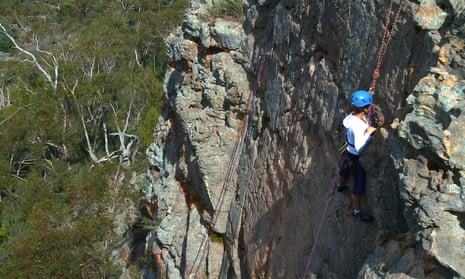Traditional owners in Victoria’s Grampians national park say they are prepared to work with rock climbers to allow the sport to continue, but not at the risk of causing further damage to cultural heritage.
Climbers have been barred from a third of the park, an area which climbing groups say contains three-quarters of the best high-quality climbing and bouldering sites, since Parks Victoria began enforcing previously ignored protected areas in March.
On Friday the authority granted a three-month extension to licensed rock-climbing tour operators to continue taking climbing groups to three designated walls within Summerday Valley provided they meet a strict set of conditions, including completing cultural heritage training and not using climber’s chalk. Any breach could lead to all operators being banned.
The Australian Climbing Association of Victoria, which formed in response to the ban, said the conditions were unworkable and the three-month extension was not long enough to allow operators to get public indemnity insurance or take bookings.
It has accused Parks Victoria of wedging climbers against traditional owners and maintains that climbers are the “natural allies” of Indigenous Australians.
But the three traditional owner corporations which have ownership of the Grampians – the Gunditj Mirring Traditional Owner Aboriginal Corporation, Eastern Maar Aboriginal Corporation and Barengi Gadjin Land Council – support the ban and have praised Parks Victoria for responding to their concerns.
Barengi Gadjin chairman Dylan Clarke said traditional owners had longstanding concerns about damage caused by rock climbing, which can include hammering metal bolts into the rock face and marks left by climbers’ chalk. There are also concerns around the cutting or wearing away of paths through the bush and the destruction of vegetation at the bottom of high traffic cliff faces.
That can cause damage to valuable heritage sites, many of which are unknown to the climbers. The Grampians contain 90% of Victoria’s registered rock art sites. Areas protected under the climbing ban include rock scatters, quarry sites, songlines and areas of intangible cultural heritage, as well as areas that house significant plants.
“Not all the sites are visible in the landscape,” Clarke said.
Eastern Maar chairman Jason Mifsud compared the debate to the ban on climbing Uluru.
He said most climbers, once they understood the heritage, were “quite embarrassed, very sympathetic and apologetic”.
Mifsud said if the new monitoring protocols in Summerday Valley proved successful, there could be scope to allow appropriately monitored and authorised climbing activity back in other areas.
“The preservation and protection of Aboriginal cultural heritage is non-negotiable,” Mifsud said. “We aren’t saying that there’s to be no climbing, what we are saying is that there is to be no further destruction of cultural heritage.”
The climbers’ association spokesman, Mike Tomkins, said climbers had “been very good stewards” of the park and were keen to see that heritage was not unintentionally damaged.
“We don’t want to go back to these areas even if we can legally until we can have this consultation with traditional owners and make a proper apology for the offence that we have caused, because we are actually mortified that we have caused offence and harm to places that we didn’t know [about],” Tomkins said.
But he said climbers were angry at Parks Victoria, which he accused of running “a smear campaign” against rock climbing and cutting the climbers out of the process. Parks said it was fulfilling its legislated responsibility to conserve natural and cultural values.
Tomkins said maintaining the current restrictions, which includes “bucket list” areas such as The Gallery, the Millennium Caves, and the Hollow Mountain Cave, would undermine rock-climbing tourism.
Mount Arapiles, which is west of the national park, is not subject to any restrictions but is undergoing a new cultural heritage survey.
“People travel from all over the world to go to these locations … they are effectively world heritage places for rock climbers,” Tomkins said.
